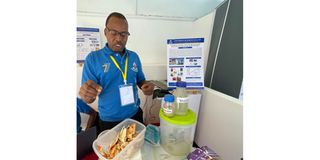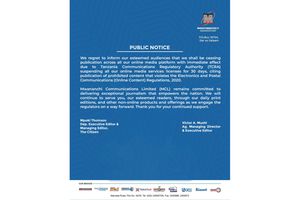Prime
Tanzanian university student develops tissues, fabrics from crab scales

What you need to know:
- The crab scales, currently ending up in various landfills, when mixed with seaweed, can produce fibres for stitching patients’ wounds in hospitals, different types of clothing, and even white hand tissues
Dar es Salaam. A postgraduate student of the University of Dar es Salaam (UDSM), Mr Cosmas Kindole, has developed a method of producing fibres and fabrics through crab scales.
This is part of efforts to fight against environmental pollution caused by indiscriminate waste disposal.
The crab scales, currently ending up in various landfills, when mixed with seaweed, can produce fibres for stitching patients’ wounds in hospitals, different types of clothing, and even white hand tissues.
Mr Kindole, who doubles as an assistant lecturer at the university, said the proliferation of such waste inspired him to think of ways to bring them back into use in different forms.
He said one of the products made is fibre used to make clothes and hospital stitches.
"So we have been able to use the waste thrown away in the streets and return it to use in other ways. The statistics we have show that East Africa produces between six and eight million metric tonnes of these crab scales annually, and all are thrown away as waste," said Mr Kindole.
Further, he said, through seaweed and the crab scales, they have been able to develop biodegradable plastic that can be used for food packaging.
This means a cake and its casing can both be eaten as food without causing any health problems.
According to Mr Kindole, only 500 grammes of the crab scales are enough to produce one litre of fluid (gel) that has the potential to produce many fibres for making a sweater and two jeans.
"This is part of my work in my postgraduate studies. We have already experimented with these fibres in sewing clothes, and they are of high quality. On the human side, we have not yet done experiments because it is difficult to use the human body for experiments," said Mr Kindole.
Currently, he said he is in the various stages of completing his research, which, he believes, will later be used properly to help fight environmental pollution and create jobs through the production of various products.
Reacting to the innovation, one of the visitors to the 48th Dar es Salaam International Trade Fair Grounds, Ezekiel Kaswagula said that if the idea is fully implemented, it will be of great benefit.
"What needs to be done in the future is to provide education on waste separation. If it is hotels selling such foods, then they should know how to put what is needed on the side and not mix with some other waste to facilitate ease in retrieval," Mr Kaswagula suggested.





